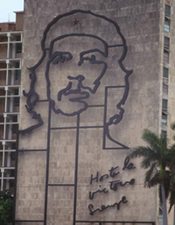
Latin American revolutions are often bloody affairs. Images of Che Guevara-type guerrillas backed by Soviet military hardware and overthrowing corrupt regimes are the stuff of outdated and maudlin Marxist mythology.
Such images are old hat. South of the border, something new is emerging. Today’s guerrillas are on the Internet. They are armed with cellular phones and satellite communications. When not in mountain hideouts, they show up at international conferences and organize world network support groups who sell their books on Amazon.com. And while they still use violence and brutal killing to accomplish their Marxist goals, their battlefield more often shifts from the jungle to the front pages with impressive and surreal displays of street theater.
Today’s proletariat has also changed. No longer carried out only in the name of poor workers or landless peasants, today’s revolution stretches the definition of “oppressed” to include minorities, homosexuals and just about anyone with an ax to grind against the system.
It is a mysterious postmodern revolution uniting all struggles. In the words of one guerrilla group, all form “a collective network of all our particular struggles and resistances. An intercontinental network of resistance against neoliberalism, an intercontinental network of resistance for humanity.”1
It is international yet has no international structure. “This intercontinental network of resistance is not an organizing structure; it doesn’t have a central head or decision maker; it has no central command or hierarchies. We are the network, all of us who resist.”2
With the devotion of the Afghan Taliban, these mysterious neo-Marxists seem intent on destroying not Buddhist shrines but enshrined principles of the modern state and the rule of law. They do not seek central power like the old Leninists but an even more radical agenda of local self-managing soviets based on total equality.
The Zapatista Road Show
A revealing example of these postmodern revolutionaries is the Zapatista movement. Rarely has a movement gained such instant notoriety as the Zapatista National Liberation Army in Mexico. For seven years, the motley group of rebels has terrorized Chiapas state demanding rights and autonomy for the region’s indigenous population. The army has all but reduced them to military impotence.
Suddenly, twenty-three Zapatista “commanders” led by a mysterious Subcommander Marcos donned ski masks and took their cause to Mexico’s capital by organizing a two-week 2,000-mile procession across Mexico.

The roundabout trek resembled a political campaign more than a rights march. Rural villages, tourist towns and industrial centers were the ideal photo-ops. According to the Brazilian newspaper, Jornal do Brasil, an escort of 200 European leftists volunteered to act as “security” for the Zapatistas after the International Red Cross refused. Criticized as “revolutionary tourists,” these figures included Danielle Mitterrand, widow of France’s former socialist president, Jose Saramago, Nobel Literature laureate, and French sociologists Alain Touraine and Ivon Le Bot. Even French anti-globalist Jose Bove showed up for the march.3
The triumphal rebels were also escorted and protected along the way by the Mexican government. Journalists quickly forced a parallel between the 24 rebels’ entry into the capital and Emiliano Zapata’s military capture of the city in 1914.
The New Proletariat
The culmination of the march was a March 11 rally in Mexico City. There, tens of thousands of supporters filled the city’s central square while masked rebels railed in a show of revolutionary bravado and Trotskyite boilerplate.
Subcommander Marcos raised his fist in the air and shouted, “We are here to shout for and to demand democracy, liberty and justice.”4 Commander Esther, and commanders Zebedeo, Tacho and David also addressed the masses.
The crowd consisted of more than just poor Indians. Observers at the rally noted government workers, university professors, farmers, pierced and painted punks, Catholics, gays and lesbians showing solidarity.
Indeed, there is no evidence that the Zapatista movement can claim to represent the 10 million poor people of indigenous descent. Even in Chiapas, they have no real or tested political base. Yet buoyed by their sudden media exposure, the masked Zapatistas have stolen a mantle of legitimacy and come to negotiate with the government and will not leave until their demands are met.
Outfoxing the Fox
Tragically, the main strength of the Zapatista movement is the weakness of the government of President Vincente Fox. In fact, his outreach toward the guerrillas breathed new life into the moribund group. Although the target of Zapatista insults, Mr. Fox has bent over backwards to accommodate them. He has released prisoners and removed military personnel from the state of Chiapas.
Moreover, he has promised to push through Congress a constitutional amendment which would enshrine the Zapatista demands. On his weekly radio program, he welcomed the Zapatista caravan with cries: “Let Zapatism win! May the subcommander (Marcos) win!”5

San Andrés Accords
The centerpiece of the conflict is an Indian rights bill called the San Andrés Accords. The measure would grant limited autonomy to nearly 50 tribal groups. The passage of the accords would require a two-thirds majority vote in Congress and promises to be only the beginning of a process that will inevitably lead to more demands.
The accords would grant limited forms of autonomy to indigenous people and effectively create a hodge-podge of tribal councils, tribunals and cultural institutions. It would also legitimize parallel governing structures already set up by the Zapatistas and other competing groups – a standard destabilizing Marxist tactic. Critics point out the accords would balkanize the country with some regions ruled by constitutional codes and others by so-called Indian customs.
Moreover, the accords come at a time when many Indian communities are not even united among themselves. Such communities have been torn for generations by struggles and vendettas over land, religion and power. In northern Chiapas alone, 160 people have been killed in political clashes over the last five years. Ironically, the very local customs the Zapatistas claim to enshrine have set the stage for some of the violence.6
We are so Radical…
In such a climate of instability, this Zapatista Taliban, faithful to its fundamentalist Marxist creed, is not enshrining local customs. Behind the façade of indigenous rights, it is creating all the conditions for destroying existing political structures and instituting confiscatory land reform. Primitive socialist communities with bottom-up democracy are to be the norm.
In the “liberated” areas, they have already set up local structures where people’s assemblies rule and all over 12 may vote. The Zapatistas themselves admit they are radical because their goal is “the construction of a political practice which does not seek the taking of power but the organization of society.”7
Indeed, this advanced Marxist ideal is different. It leapfrogs the dictatorship of the proletariat and state socialism that failed in Eastern Europe. Their goal is the self-managing Marxist ideal where the state would disappear allowing the rule of total equality through their local assemblies. It is not without reason that the Zapatistas claim: “ We are so radical that we do not fit in the parameters of ‘modern political science.’”8
For the complete text of this message, Click Here.)
Economically, this radicality translates into actions supplanting the rule of law and establishing local communities according to the will of the majority of the people who “organize themselves, taking land, respecting small rural property and working in collectives, ignoring all of the debts with the government.9 Production of each collective goes to its members; while the surplus goes into a central community fund controlled by the assembly.

A Liberating Church
Not surprisingly, proponents of liberation theology have given them their ardent support. They have proposed their own models of an indigenous church not unlike the political models sought in the San Andrés Accords.
The controversial Bishop Samuel Ruiz García, who has since retired, introduced an autonomous “liberating” church within the context of Indian cultural forms10 where even church officials were chosen by the diocesan assembly and baptisms approved by the community.
Zapatistas make no secret of their rejection of Spanish culture and the traditional Catholic Indian evangelization. Rather than try to harmonize class differences, they use small basic faith communities as a vehicle for class struggle.
No World Outcry
There was world outcry when ancient Buddhas were destroyed by fundamentalist militiamen in Afghanistan. Most nations still refused to recognize the Taliban movement’s legitimacy.
And yet with what ease the Zapatistas rocketed to legitimacy. Self-proclaimed commanders without names, commissions or political bases suddenly appear and present demands to an elected government. Clinging to their primitive Marxist fundamentalism, these militants take pot shots at the enshrined principles of private property, civil government and rule of law. These poor indigenous guerrillas surf the Internet, jet to international socialist meetings and attract leftists from all over the world.
There is no outcry against this militia. Everywhere, there is sympathy. The Zapatistas have stolen the show in an act of Talibanditry and no one seems to have noticed.
Footnotes
- Fourth Declaration of the Lacandon Jungle, January 1, 1996, http://www.struggle.ws/mexico/ezln/jung4.html
- Ibid.
- “Marcha zapatista tem recepcao triumphal,” Journal do Brasil, 3-12-2001
- Ginger Thompson and Tim Weiner, “2-Week Trek Culminates in Rally for Indian Rights in Mexico City,” The New York Times, 3/12/201
- “Marcha zapatista chega a capital,” Journal da Tarde, 3-11-2001
- Ginger Thompson,” Why Peace Eludes Mexico’s Indians,” The New York Times, 3-11-2001.
- “What makes us different is our political proposal” Marcos, August 30, 1996, http://www.struggle.ws/mexico/ezln/marc_to_cs_se96.html
- Ibid.
- 14 Excerpted transcriptions that were published in La Jornada. They were recorded in San Cristobal de las Casas just after the EZLN liberated the city on January 1, 1994, and the transcription was published in La Jornada http://www.struggle.ws/mexico/ezln/marcos_interview_jan94.html
- Gary MacEoin, “New Chiapas bishop steps in with caution,” National Catholic Reporter, 6-16-2000.

